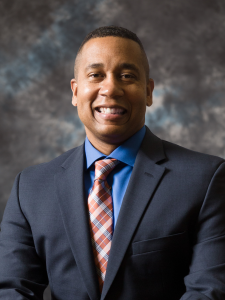Trusting Election Technology
Juan Gilbert has worked on election technology for nearly two decades. He sees solutions on the horizon that can increase trust—and problems, too.
When Juan Gilbert, Ph.D., created Prime III election software almost two decades ago, allowing anyone regardless of physical disabilities to vote using the same machine, he began getting some very revealing questions.

People would ask who owns the software and find out that Gilbert did. The next question was invariably about his politics. “That is one reason we never patented this technology or anything, because it was creating a trust scenario,” said Gilbert, chair of the Department of Computer & Information Science & Engineering at the University of Florida’s College of Engineering. “If you own it, they have to understand your political standing.”
Through his work in election technology and artificial intelligence systems, Gilbert has a unique window on America’s relationship with technology and the levers that impact trust. His concept of human-centered computing takes real-world problems such as voting and provides technology solutions that are understandable and usable—and may ultimately increase trust.
| Click here to read a Q&A with Juan Gilbert. |
In the case of Prime III, the answer was to increase transparency by making the source code available widely. “I started saying, ‘it is open-source, it is in the open domain,’” Gilbert said. “No one asks me how I vote anymore.”
Technology Can Increase Trust
Gilbert is still creating election systems. In August, he and his team released the inLine Ticketing System, which cities and counties used to eliminate voting lines and decrease risk during the Covid pandemic.
The system, which could also be used for coronavirus testing, allows poll workers to disperse lines by handing voters tickets that set a time for them to come back later and fill in their ballots. It eliminates the need for a queue.
“The inLine Ticketing System takes the risk out of waiting in line because your ticket holds your place,” Gilbert said. “Voters can keep their distance and come back at their designated time to vote as they normally would.”
Gilbert, who works with the university’s Consortium on Trust in Media and Technology, has well-defined ideas about the impact that tech has on trust. Technology, he says, is easy to demonize—especially if it is difficult to understand and hard to use. Systems like that decrease trust.
However, he also says the opposite can be true. “There are scenarios where it can increase trust,” Gilbert said. “When technology can be used and understood, then you have an opportunity to create trust. There has got to be a level of understandability, usability and comprehension. If you could create a technology that creates world peace, but no one could use it, then it is useless. The easiest way to have distrust is when something is hard to use.”
The Prognosis for Mail-in Voting
Gilbert was a member of the committee that produced “Securing the Vote: Protecting American Democracy,” a report by the National Academies of Science, Engineering and Medicine released in 2018. He testified before Congress on election security in 2020.
Gilbert said similar ideas about usability and trust can be applied to mail-in voting, which increased substantially in all 50 states as a way to vote safely amid the pandemic. Mail-in voting has existed in America since the Civil War. Yet many in politics have questioned whether it leads to widespread fraud.
Gilbert said states may have difficulty with signature verification, matching signatures on ballots to those on file with the state. But widespread fraud is unlikely, he said, because the safeguards in place generally work.
“I think it would be pretty hard,” he said. “Russia cannot just go print a bunch of ballots that will get counted. It is not going to happen.”
What should happen, he said, is voter education. “You definitely want to educate people on how it works—make sure everyone knows how mail-in voting works,” he said. “That is the best thing you can do at this point.”
